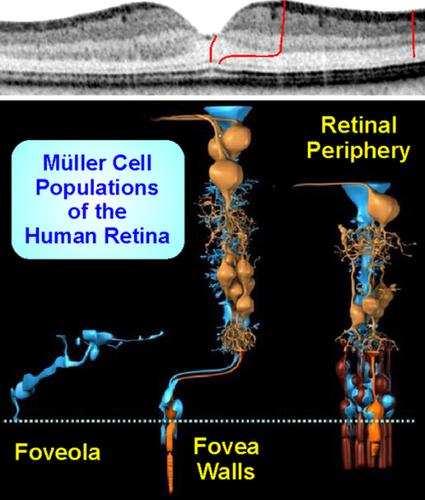Our official English website, www.x-mol.net, welcomes your
feedback! (Note: you will need to create a separate account there.)
Glia of the human retina.
Glia ( IF 5.4 ) Pub Date : 2019-12-03 , DOI: 10.1002/glia.23727 Andreas Reichenbach 1 , Andreas Bringmann 2
Glia ( IF 5.4 ) Pub Date : 2019-12-03 , DOI: 10.1002/glia.23727 Andreas Reichenbach 1 , Andreas Bringmann 2
Affiliation

|
The human retina contains three types of glial cells: microglia and two types of macroglia, astrocytes and Müller cells. Macroglia provide homeostatic and metabolic support to photoreceptors and neurons required for neuronal activity. The fovea, the site of the sharpest vision which is astrocyte- and microglia-free, contains two populations of Müller glia: cells which form the Müller cell cone in the foveola and z-shaped Müller cells of the foveal walls. Both populations are characterized by morphological and functional differences. Müller cells of the foveola do not support the activity of photoreceptors and neurons, but provide the structural stability of the foveal tissue and improve the light transmission through the tissue to the photoreceptors. This article gives overviews of the glia of the human retina and the structure and function of both Müller cell types in the fovea, and describes the contributions of astrocytes and Müller cells to the ontogenetic development of the fovea.
中文翻译:

人类视网膜的神经胶质。
人体视网膜包含三种类型的神经胶质细胞:小胶质细胞和两种类型的大胶质细胞:星形胶质细胞和穆勒细胞。大胶质细胞为神经元活动所需的光感受器和神经元提供稳态和代谢支持。中央凹,最清晰的视点,不含星形胶质细胞和小胶质细胞,包含两个Müller胶质细胞群:在中央窝形成Müller细胞锥的细胞和中央凹壁的Z形Müller细胞。两种种群都具有形态和功能上的差异。中央窝的穆勒细胞不支持感光细胞和神经元的活性,但提供中央凹组织的结构稳定性,并改善通过组织到达感光细胞的光传输。
更新日期:2019-12-03
中文翻译:

人类视网膜的神经胶质。
人体视网膜包含三种类型的神经胶质细胞:小胶质细胞和两种类型的大胶质细胞:星形胶质细胞和穆勒细胞。大胶质细胞为神经元活动所需的光感受器和神经元提供稳态和代谢支持。中央凹,最清晰的视点,不含星形胶质细胞和小胶质细胞,包含两个Müller胶质细胞群:在中央窝形成Müller细胞锥的细胞和中央凹壁的Z形Müller细胞。两种种群都具有形态和功能上的差异。中央窝的穆勒细胞不支持感光细胞和神经元的活性,但提供中央凹组织的结构稳定性,并改善通过组织到达感光细胞的光传输。











































 京公网安备 11010802027423号
京公网安备 11010802027423号